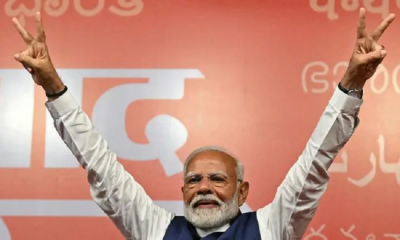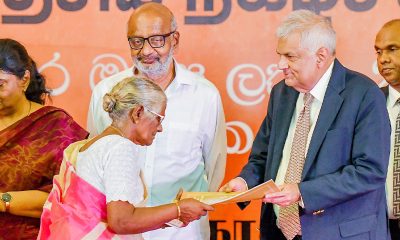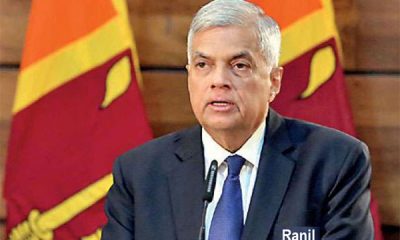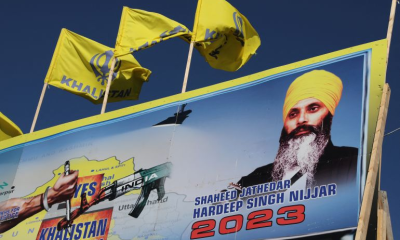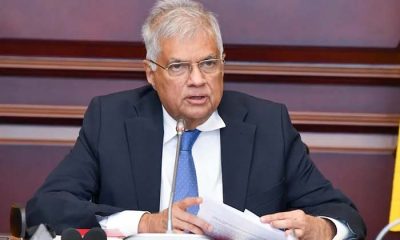Features
PM Modi’s comments: ‘Ensure dignity and respect for Tamils’
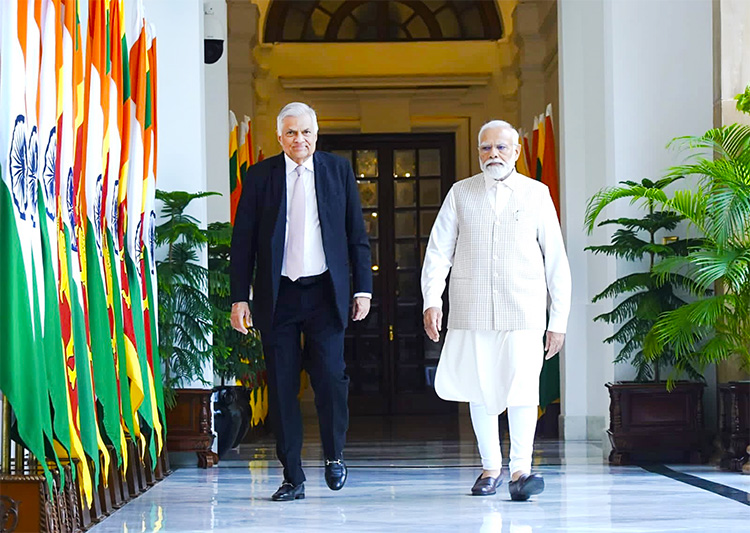
By Neville Ladduwahetty
This is not the first time that Indian Leaders have called on Sri Lankan Governments to “Ensure life of dignity and respect for Tamils”. This was repeated during the recent visit of Sri Lanka’s President to India. India’s Prime Minister Modi stated: “We hope that Sri Lanka’s government will fulfill the aspirations of the Tamil people. We expect that Colombo will take forward the process of reconstruction for ensuring equality, justice and peace. We hope that Sri Lanka will fulfill its commitment to implement the 13th Amendment and to hold provincial elections” (The Island, 23 July, 2023).
It is necessary to recognize that all the comments made by the Prime Minister exclusively addresses the concerns of the Tamil people. Furthermore, except for implementing the 13A, and holding provincial elections, all other issues relating to the Tamil people are intangible and unquantifiable notions that are influenced by perceptions. Consequently, the call to the Governments of Sri Lanka to ensure dignity and respect for Tamil people presents opportunities for India to exploit it to its advantage, at its choosing. As for the rest of Sri Lanka, it was all about tangible infrastructure projects to further connectivity and integration as incorporated in the five MOUs.
All the intangible notions are interrelated. For instance, IF Tamil aspirations for the separate State, that had led to a 30-year armed conflict, had become a reality, a life of dignity and respect for Tamils would follow, and the need for reconstruction to ensure equality, justice and peace would not have arisen. On the other hand, if the aspiration of the Tamil people had been limited to a Federal State with the right of self-determination, dignity and respect for Tamils would have been ensured, albeit not to the same degree, and the need for reconstruction to ensure equality, justice and peace would also be to a lesser degree. Therefore, the degree to which the intangible notions become relevant depend on what constitutes acceptable aspirations.
The irony is that because the aspirations of the Tamil people as hitherto articulated come at a cost to both India’s and Sri Lanka’s interests, mutual security and territorial integrity, the aspirations of the Tamil people as hitherto expressed cannot be fulfilled. This is an enigma for both India and Sri Lanka; if either aspiration of the Tamil people expressed thus far was to manifest itself in Sri Lanka, the inevitable reverberations in India would be a threat to India’s security and its territorial integrity, without which India would not be able to fulfill its aspiration of becoming a global power.
What is evident from this existential reality is that India’s and Sri Lanka’s security, territorial integrity, and its political arrangements in the form of 13A are already interlinked to a degree that makes Sri Lanka apprehensive and insecure arising from the denial of Sri Lanka’s right of self-determination. Against such a background, it is imperative that its economic connectivity conveyed in the five MOUs be handled with extreme caution if Sri Lanka is not to become even more dependent and at the mercy of India.
Under the circumstances, the most that India can accept without compromising its own interests and aspirations is devolution under the 13th Amendment, which clearly is not the aspiration of the Tamil people. The same goes for Sri Lanka’s aspiration, too, unless its form and scope is reformulated from the form and scope imposed by India in 1987 into an arrangement that better serves all Sri Lankans without exception. Taking into account these hard realities, India’s PM would be doing a great service to the Peoples of both India and Sri Lanka if he was to call on the Tamil leadership to “get real” and scale back their aspirations, because of its impact on the interrelated and interdependent interests of both India and Sri Lanka.
FIVE MOUs BETWEEN INDIA and SRI LANKA
As far as India is concerned, 13A is the most India can accept if it is to protect its national interests and its global aspirations. In such a context, 13A in Sri Lanka is being used to enhance India’s connectivity with Sri Lanka and thus bring Sri Lanka within India’s sphere of control with economic projects that on paper appear attractive, would not be in Sri Lanka’s interest in their operations. The five (05), yet unpublished MOUs signed with India during the visit of Sri Lanka’s President is all about connectivity to the point of integration and eventual dependence. These MOUs have little to do with “dignity and respect for Tamils or their aspirations. On the other hand, it has everything to do with India’s policy of Neighbourhood First and Security and Growth for all in the Region (SAGAR), thereby furthering India’s interests.
Although the five MOUs signed do not have a legal status, they clearly outline specific points of understanding. In particular, they describe the projects on which India and Sri Lanka have agreed to explore areas of mutual interest. However, it is of vital importance to recognize that while some projects would be mutually beneficial, others would compromise the self-reliance and independence of Sri Lanka, and in the process further the dependence of Sri Lanka on India through these physical connections.
For instance:
The construction of a multi-product petroleum pipeline from Southern part of India to Sri Lanka.
To establish high capacity power grid between India and Sri Lanka.
The decision to designate INR as currency for trade between the two countries.
To establish land connectivity between India and Sri Lanka for developing access to ports of Trincomalee and Colombo.
Establishing physical connections in respect of a pipeline for petroleum products and a power grid between India and Sri Lanka could be disrupted at any time as experienced by Europe, when the pipelines that had delivered natural gas and petroleum products from Russia were sabotaged by interested parties. On 26 September, 2022, a series of clandestine bombings and subsequent underwater gas leaks occurred on the Nord Stream 1 and Nord Stream 2 natural gas pipelines. Following the sabotage, “the European Commission has unveiled an ambitious and far-reaching plan, aptly coined “REPower EU”, to achieve full energy independence from Russia by 2027″ (euronews). Earlier, the pipeline had delivered 45% of natural gas from Russia to Europe; a dependence that the US had perceived as being hostage to Russia. Since similar acts of terrorism cannot be ruled out in the case of any underwater pipeline from India to Sri Lanka, the lesson to be learnt from Europe is to develop independent sources of energy and not rely on external sources that could exploit such dependence to advance the interests of others.
Similar vulnerabilities exist with power grids, too. Whether the cables are over-water or submarine cables, cyber hackers have exploited the vulnerabilities of power grids in Europe and in the US. Since such hackers could be induced by geopolitically motivated interests, the vulnerability associated with trans-national grids are greater than with national grids. Therefore, confining power grids within national boarders is more prudent.
The land access to ports of Trincomalee and Colombo presents multidimensional threats. Access to ports would mostly be by road. This means the routes they traverse and their surroundings would be subjected to serious environmental hazards arising from vehicular emissions. Furthermore, since road access would encourage human traffic, Sri Lanka would be forced to deal not only with unfamiliar health issues but also equip itself to deal with increased drug traffic, both by land and sea.
The decision to designate INR as currency for trade between India and Sri Lanka appears favourable to Sri Lanka, at first glance, given the fact that Imports from India to Sri Lanka in 2022 were around $4.5 Billion while Exports from Sri Lanka to India were only $ 850 Million. Under these circumstances, Sri Lanka would be able to save follars because currently the US Dollar is the currency of trade with India.
However, the very fact that using INR for trade may be an advantage to Sri Lanka, there is a strong possibility that imports from India would not only increase but also be at a cost to quality, as experienced with the pharmaceutical products that are imported from India on a Line of Credit. The net effect would be for Sri Lanka to become more and more indebted to India.
CONCLUSION
After having issued the usual platitudes, such as fulfilling aspirations of the Tamil people, ensuring “dignity and respect for Tamils” and “equality, justice and peace for them, Sri Lanka was admonished for its lack of commitment for implementing the 13th Amendment by Prime Minister Modi during the recent visit of the President of Sri Lanka to India. India wrapped up the visit by securing agreements conveyed in five MOUs to engage in infrastructure projects that consolidate India’s connectivity with Sri Lanka thereby ensuring the dependence through its policy of neighbourhood first. In short, Sri Lanka came home with the short end of the stick.
No serious attempt was made by Sri Lanka to explain to India that the reason for not fulfilling Tamil aspirations is simply not a lack of commitment or the unwillingness, but because the aspirations of the Tamil people run counter to the aspirations of the rest in Sri Lanka. Furthermore, no attempt was made to explain that the 13A imposed by India was from the beginning drafted and crafted from the outset ONLY to meet Tamil aspirations, and not as a mechanism to improve the lives of ALL Sri Lankans through effective devolution. Consequently, 13A has turned out to be a trap where the choice boils down to aspirations of Tamil people or improved livelihoods for all. No attempt was made by Sri Lanka to explore ways and means of getting out of this trap. This should have been Sri Lanka’s focus. Instead, what turned out was control of Sri Lanka by India through connectivity and integration.
It has to be granted that some issues contained in the MOUs are mutually beneficial. However, issues such as connectivity of land access to ports of Trincomalee and Colombo, power grids, under sea pipelines to convey petroleum products and trade in INR have vulnerabilities that are influenced by geopolitics as experienced by Europe when the Russian pipelines were sabotaged; a dependence that was described as being a hostage to Russia according to the US. The very quick lesson, learnt by Europe, was to be free of connectivity. This should be Sri Lanka’s lesson too. Therefore, extreme caution will have to be exercised when issues contained in these MOUs, are transformed for implementation.
Features
The heart-friendly health minister

by Dr Gotabhya Ranasinghe
Senior Consultant Cardiologist
National Hospital Sri Lanka
When we sought a meeting with Hon Dr. Ramesh Pathirana, Minister of Health, he graciously cleared his busy schedule to accommodate us. Renowned for his attentive listening and deep understanding, Minister Pathirana is dedicated to advancing the health sector. His openness and transparency exemplify the qualities of an exemplary politician and minister.
Dr. Palitha Mahipala, the current Health Secretary, demonstrates both commendable enthusiasm and unwavering support. This combination of attributes makes him a highly compatible colleague for the esteemed Minister of Health.
Our discussion centered on a project that has been in the works for the past 30 years, one that no other minister had managed to advance.
Minister Pathirana, however, recognized the project’s significance and its potential to revolutionize care for heart patients.
The project involves the construction of a state-of-the-art facility at the premises of the National Hospital Colombo. The project’s location within the premises of the National Hospital underscores its importance and relevance to the healthcare infrastructure of the nation.
This facility will include a cardiology building and a tertiary care center, equipped with the latest technology to handle and treat all types of heart-related conditions and surgeries.
Securing funding was a major milestone for this initiative. Minister Pathirana successfully obtained approval for a $40 billion loan from the Asian Development Bank. With the funding in place, the foundation stone is scheduled to be laid in September this year, and construction will begin in January 2025.
This project guarantees a consistent and uninterrupted supply of stents and related medications for heart patients. As a result, patients will have timely access to essential medical supplies during their treatment and recovery. By securing these critical resources, the project aims to enhance patient outcomes, minimize treatment delays, and maintain the highest standards of cardiac care.
Upon its fruition, this monumental building will serve as a beacon of hope and healing, symbolizing the unwavering dedication to improving patient outcomes and fostering a healthier society.We anticipate a future marked by significant progress and positive outcomes in Sri Lanka’s cardiovascular treatment landscape within the foreseeable timeframe.
Features
A LOVING TRIBUTE TO JESUIT FR. ALOYSIUS PIERIS ON HIS 90th BIRTHDAY

by Fr. Emmanuel Fernando, OMI
Jesuit Fr. Aloysius Pieris (affectionately called Fr. Aloy) celebrated his 90th birthday on April 9, 2024 and I, as the editor of our Oblate Journal, THE MISSIONARY OBLATE had gone to press by that time. Immediately I decided to publish an article, appreciating the untiring selfless services he continues to offer for inter-Faith dialogue, the renewal of the Catholic Church, his concern for the poor and the suffering Sri Lankan masses and to me, the present writer.
It was in 1988, when I was appointed Director of the Oblate Scholastics at Ampitiya by the then Oblate Provincial Fr. Anselm Silva, that I came to know Fr. Aloy more closely. Knowing well his expertise in matters spiritual, theological, Indological and pastoral, and with the collaborative spirit of my companion-formators, our Oblate Scholastics were sent to Tulana, the Research and Encounter Centre, Kelaniya, of which he is the Founder-Director, for ‘exposure-programmes’ on matters spiritual, biblical, theological and pastoral. Some of these dimensions according to my view and that of my companion-formators, were not available at the National Seminary, Ampitiya.
Ever since that time, our Oblate formators/ accompaniers at the Oblate Scholasticate, Ampitiya , have continued to send our Oblate Scholastics to Tulana Centre for deepening their insights and convictions regarding matters needed to serve the people in today’s context. Fr. Aloy also had tried very enthusiastically with the Oblate team headed by Frs. Oswald Firth and Clement Waidyasekara to begin a Theologate, directed by the Religious Congregations in Sri Lanka, for the contextual formation/ accompaniment of their members. It should very well be a desired goal of the Leaders / Provincials of the Religious Congregations.
Besides being a formator/accompanier at the Oblate Scholasticate, I was entrusted also with the task of editing and publishing our Oblate journal, ‘The Missionary Oblate’. To maintain the quality of the journal I continue to depend on Fr. Aloy for his thought-provoking and stimulating articles on Biblical Spirituality, Biblical Theology and Ecclesiology. I am very grateful to him for his generous assistance. Of late, his writings on renewal of the Church, initiated by Pope St. John XX111 and continued by Pope Francis through the Synodal path, published in our Oblate journal, enable our readers to focus their attention also on the needed renewal in the Catholic Church in Sri Lanka. Fr. Aloy appreciated very much the Synodal path adopted by the Jesuit Pope Francis for the renewal of the Church, rooted very much on prayerful discernment. In my Religious and presbyteral life, Fr.Aloy continues to be my spiritual animator / guide and ongoing formator / acccompanier.
Fr. Aloysius Pieris, BA Hons (Lond), LPh (SHC, India), STL (PFT, Naples), PhD (SLU/VC), ThD (Tilburg), D.Ltt (KU), has been one of the eminent Asian theologians well recognized internationally and one who has lectured and held visiting chairs in many universities both in the West and in the East. Many members of Religious Congregations from Asian countries have benefited from his lectures and guidance in the East Asian Pastoral Institute (EAPI) in Manila, Philippines. He had been a Theologian consulted by the Federation of Asian Bishops’ Conferences for many years. During his professorship at the Gregorian University in Rome, he was called to be a member of a special group of advisers on other religions consulted by Pope Paul VI.
Fr. Aloy is the author of more than 30 books and well over 500 Research Papers. Some of his books and articles have been translated and published in several countries. Among those books, one can find the following: 1) The Genesis of an Asian Theology of Liberation (An Autobiographical Excursus on the Art of Theologising in Asia, 2) An Asian Theology of Liberation, 3) Providential Timeliness of Vatican 11 (a long-overdue halt to a scandalous millennium, 4) Give Vatican 11 a chance, 5) Leadership in the Church, 6) Relishing our faith in working for justice (Themes for study and discussion), 7) A Message meant mainly, not exclusively for Jesuits (Background information necessary for helping Francis renew the Church), 8) Lent in Lanka (Reflections and Resolutions, 9) Love meets wisdom (A Christian Experience of Buddhism, 10) Fire and Water 11) God’s Reign for God’s poor, 12) Our Unhiddden Agenda (How we Jesuits work, pray and form our men). He is also the Editor of two journals, Vagdevi, Journal of Religious Reflection and Dialogue, New Series.
Fr. Aloy has a BA in Pali and Sanskrit from the University of London and a Ph.D in Buddhist Philosophy from the University of Sri Lankan, Vidyodaya Campus. On Nov. 23, 2019, he was awarded the prestigious honorary Doctorate of Literature (D.Litt) by the Chancellor of the University of Kelaniya, the Most Venerable Welamitiyawe Dharmakirthi Sri Kusala Dhamma Thera.
Fr. Aloy continues to be a promoter of Gospel values and virtues. Justice as a constitutive dimension of love and social concern for the downtrodden masses are very much noted in his life and work. He had very much appreciated the commitment of the late Fr. Joseph (Joe) Fernando, the National Director of the Social and Economic Centre (SEDEC) for the poor.
In Sri Lanka, a few religious Congregations – the Good Shepherd Sisters, the Christian Brothers, the Marist Brothers and the Oblates – have invited him to animate their members especially during their Provincial Congresses, Chapters and International Conferences. The mainline Christian Churches also have sought his advice and followed his seminars. I, for one, regret very much, that the Sri Lankan authorities of the Catholic Church –today’s Hierarchy—- have not sought Fr.
Aloy’s expertise for the renewal of the Catholic Church in Sri Lanka and thus have not benefited from the immense store of wisdom and insight that he can offer to our local Church while the Sri Lankan bishops who governed the Catholic church in the immediate aftermath of the Second Vatican Council (Edmund Fernando OMI, Anthony de Saram, Leo Nanayakkara OSB, Frank Marcus Fernando, Paul Perera,) visited him and consulted him on many matters. Among the Tamil Bishops, Bishop Rayappu Joseph was keeping close contact with him and Bishop J. Deogupillai hosted him and his team visiting him after the horrible Black July massacre of Tamils.
Features
A fairy tale, success or debacle

Sri Lanka-Singapore Free Trade Agreement
By Gomi Senadhira
senadhiragomi@gmail.com
“You might tell fairy tales, but the progress of a country cannot be achieved through such narratives. A country cannot be developed by making false promises. The country moved backward because of the electoral promises made by political parties throughout time. We have witnessed that the ultimate result of this is the country becoming bankrupt. Unfortunately, many segments of the population have not come to realize this yet.” – President Ranil Wickremesinghe, 2024 Budget speech
Any Sri Lankan would agree with the above words of President Wickremesinghe on the false promises our politicians and officials make and the fairy tales they narrate which bankrupted this country. So, to understand this, let’s look at one such fairy tale with lots of false promises; Ranil Wickremesinghe’s greatest achievement in the area of international trade and investment promotion during the Yahapalana period, Sri Lanka-Singapore Free Trade Agreement (SLSFTA).
It is appropriate and timely to do it now as Finance Minister Wickremesinghe has just presented to parliament a bill on the National Policy on Economic Transformation which includes the establishment of an Office for International Trade and the Sri Lanka Institute of Economics and International Trade.
Was SLSFTA a “Cleverly negotiated Free Trade Agreement” as stated by the (former) Minister of Development Strategies and International Trade Malik Samarawickrama during the Parliamentary Debate on the SLSFTA in July 2018, or a colossal blunder covered up with lies, false promises, and fairy tales? After SLSFTA was signed there were a number of fairy tales published on this agreement by the Ministry of Development Strategies and International, Institute of Policy Studies, and others.
However, for this article, I would like to limit my comments to the speech by Minister Samarawickrama during the Parliamentary Debate, and the two most important areas in the agreement which were covered up with lies, fairy tales, and false promises, namely: revenue loss for Sri Lanka and Investment from Singapore. On the other important area, “Waste products dumping” I do not want to comment here as I have written extensively on the issue.
1. The revenue loss
During the Parliamentary Debate in July 2018, Minister Samarawickrama stated “…. let me reiterate that this FTA with Singapore has been very cleverly negotiated by us…. The liberalisation programme under this FTA has been carefully designed to have the least impact on domestic industry and revenue collection. We have included all revenue sensitive items in the negative list of items which will not be subject to removal of tariff. Therefore, 97.8% revenue from Customs duty is protected. Our tariff liberalisation will take place over a period of 12-15 years! In fact, the revenue earned through tariffs on goods imported from Singapore last year was Rs. 35 billion.
The revenue loss for over the next 15 years due to the FTA is only Rs. 733 million– which when annualised, on average, is just Rs. 51 million. That is just 0.14% per year! So anyone who claims the Singapore FTA causes revenue loss to the Government cannot do basic arithmetic! Mr. Speaker, in conclusion, I call on my fellow members of this House – don’t mislead the public with baseless criticism that is not grounded in facts. Don’t look at petty politics and use these issues for your own political survival.”
I was surprised to read the minister’s speech because an article published in January 2018 in “The Straits Times“, based on information released by the Singaporean Negotiators stated, “…. With the FTA, tariff savings for Singapore exports are estimated to hit $10 million annually“.
As the annual tariff savings (that is the revenue loss for Sri Lanka) calculated by the Singaporean Negotiators, Singaporean $ 10 million (Sri Lankan rupees 1,200 million in 2018) was way above the rupees’ 733 million revenue loss for 15 years estimated by the Sri Lankan negotiators, it was clear to any observer that one of the parties to the agreement had not done the basic arithmetic!
Six years later, according to a report published by “The Morning” newspaper, speaking at the Committee on Public Finance (COPF) on 7th May 2024, Mr Samarawickrama’s chief trade negotiator K.J. Weerasinghehad had admitted “…. that forecasted revenue loss for the Government of Sri Lanka through the Singapore FTA is Rs. 450 million in 2023 and Rs. 1.3 billion in 2024.”
If these numbers are correct, as tariff liberalisation under the SLSFTA has just started, we will pass Rs 2 billion very soon. Then, the question is how Sri Lanka’s trade negotiators made such a colossal blunder. Didn’t they do their basic arithmetic? If they didn’t know how to do basic arithmetic they should have at least done their basic readings. For example, the headline of the article published in The Straits Times in January 2018 was “Singapore, Sri Lanka sign FTA, annual savings of $10m expected”.
Anyway, as Sri Lanka’s chief negotiator reiterated at the COPF meeting that “…. since 99% of the tariffs in Singapore have zero rates of duty, Sri Lanka has agreed on 80% tariff liberalisation over a period of 15 years while expecting Singapore investments to address the imbalance in trade,” let’s turn towards investment.
Investment from Singapore
In July 2018, speaking during the Parliamentary Debate on the FTA this is what Minister Malik Samarawickrama stated on investment from Singapore, “Already, thanks to this FTA, in just the past two-and-a-half months since the agreement came into effect we have received a proposal from Singapore for investment amounting to $ 14.8 billion in an oil refinery for export of petroleum products. In addition, we have proposals for a steel manufacturing plant for exports ($ 1 billion investment), flour milling plant ($ 50 million), sugar refinery ($ 200 million). This adds up to more than $ 16.05 billion in the pipeline on these projects alone.
And all of these projects will create thousands of more jobs for our people. In principle approval has already been granted by the BOI and the investors are awaiting the release of land the environmental approvals to commence the project.
I request the Opposition and those with vested interests to change their narrow-minded thinking and join us to develop our country. We must always look at what is best for the whole community, not just the few who may oppose. We owe it to our people to courageously take decisions that will change their lives for the better.”
According to the media report I quoted earlier, speaking at the Committee on Public Finance (COPF) Chief Negotiator Weerasinghe has admitted that Sri Lanka was not happy with overall Singapore investments that have come in the past few years in return for the trade liberalisation under the Singapore-Sri Lanka Free Trade Agreement. He has added that between 2021 and 2023 the total investment from Singapore had been around $162 million!
What happened to those projects worth $16 billion negotiated, thanks to the SLSFTA, in just the two-and-a-half months after the agreement came into effect and approved by the BOI? I do not know about the steel manufacturing plant for exports ($ 1 billion investment), flour milling plant ($ 50 million) and sugar refinery ($ 200 million).
However, story of the multibillion-dollar investment in the Petroleum Refinery unfolded in a manner that would qualify it as the best fairy tale with false promises presented by our politicians and the officials, prior to 2019 elections.
Though many Sri Lankans got to know, through the media which repeatedly highlighted a plethora of issues surrounding the project and the questionable credentials of the Singaporean investor, the construction work on the Mirrijiwela Oil Refinery along with the cement factory began on the24th of March 2019 with a bang and Minister Ranil Wickremesinghe and his ministers along with the foreign and local dignitaries laid the foundation stones.
That was few months before the 2019 Presidential elections. Inaugurating the construction work Prime Minister Ranil Wickremesinghe said the projects will create thousands of job opportunities in the area and surrounding districts.
The oil refinery, which was to be built over 200 acres of land, with the capacity to refine 200,000 barrels of crude oil per day, was to generate US$7 billion of exports and create 1,500 direct and 3,000 indirect jobs. The construction of the refinery was to be completed in 44 months. Four years later, in August 2023 the Cabinet of Ministers approved the proposal presented by President Ranil Wickremesinghe to cancel the agreement with the investors of the refinery as the project has not been implemented! Can they explain to the country how much money was wasted to produce that fairy tale?
It is obvious that the President, ministers, and officials had made huge blunders and had deliberately misled the public and the parliament on the revenue loss and potential investment from SLSFTA with fairy tales and false promises.
As the president himself said, a country cannot be developed by making false promises or with fairy tales and these false promises and fairy tales had bankrupted the country. “Unfortunately, many segments of the population have not come to realize this yet”.
(The writer, a specialist and an activist on trade and development issues . )


